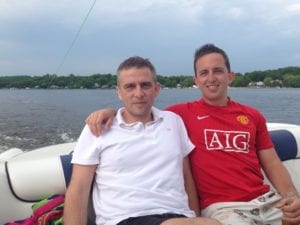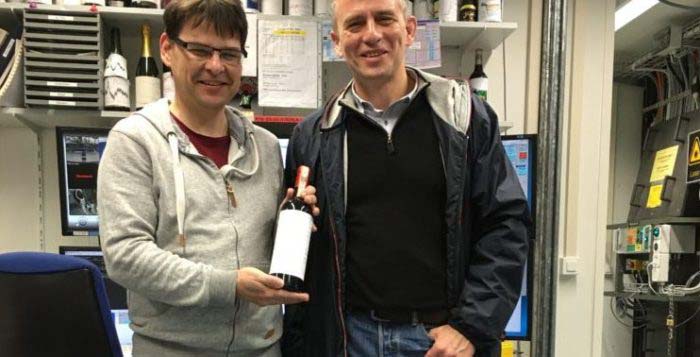SBU, BNL’s Frenkel combats chemical weapons with fine structure
By Daniel Dunaief
First responders, soldiers or those exposed to any kind of chemical weapons attack need a way to remove the gas from the air. While masks with activated carbon have been effective, the latest technological breakthrough involving a metal organic framework may not only remove the gas, but it could also disarm and decompose it.
That’s the recent finding from research led by Anatoly Frenkel in a study on a substance that simulates the action of sarin nerve gas.
Frenkel, who is a senior chemist at Brookhaven National Laboratory and a professor in the Department of Materials Science and Chemical Engineering at Stony Brook University, worked with metal organic frameworks, which contain zirconium cluster nodes that are connected through a lattice of organic linkages.

These structures would “do the job even without any catalytic activity,” Frenkel said, because they are porous and capture gases as they pass through them. “It’s like a sponge that can take in moisture. Its high porosity was already an asset.”
Frenkel and his colleagues, which include John Morris and Diego Troya from Virginia Tech, Wesley Gordon from Edgewood Chemical Biological Center and Craig Hill from Emory University, among other contributors, suspected that these frameworks might also decompose the gas.
Theoretically, researchers had predicted this might be the case, although they had no proof. Frenkel and his team used a differential method to see what was left in the structure after the gas passed through. Their studies demonstrated a high density of electrons near the zirconium atoms. “These were like bread crumbs congregated around a place where the zirconium nodes with the connecting linkers were,” Frenkel said.
While this work, which the scientists published in the Journal of the American Chemical Society, has implications for protecting soldiers or civilians in the event of a chemical weapons attack, Frenkel and his colleagues, who received funding from the Defense Threat Reduction Agency, can share their results with the public and scientific community because they are not working on classified materials and they used a substance that’s similar to a nerve gas and not sarin or any other potentially lethal gas.
“This knowledge can be transferred to classified research,” Frenkel said. “This is a stepping stone.” Indeed, Frenkel can envision the creation of a mask that includes a metal organic framework that removes deadly nerve gases from the air and, at the same time, disarms the gas, providing a defense for first responders or the military after a chemical weapons attack. Even though he doesn’t work in this arena, Frenkel also described how manufacturers might use these frameworks in treating the fabric that is used to make clothing that can prevent gases that can be harmful to the skin from making contact.
A physicist by training, Frenkel’s work, which includes collaborations on five other grants, has a common theme: He explores the relationship between structure and function, particularly in the world of nanomaterials, where smaller materials with large surface areas have applications in a range of industries, from storing and transmitting energy to delivering drugs or pharmaceuticals to a targeted site.
Eric Stach, a group leader in electron microscopy at BNL, has collaborated with Frenkel and suggested that his colleague has helped “develop all these approaches for characterizing these materials.” Stach said that Frenkel has “an outstanding reputation internationally” as an expert in X-ray absorption spectroscopy, and, in particular, a subarea that allows scientists to learn about extremely subtle changes in the distance between atoms when they are subjected to reactive environments.
Frenkel said some of the next steps in the work with metal organic frameworks include understanding how these materials might become saturated with decomposed gas after they perform their catalytic function. “It’s not clear what can affect saturation,” he said, and that is something that “needs to be systematically investigated.” After the catalyst reaches saturation, it would also be helpful to know whether it’s possible to remove the remaining compound and reuse the catalyst.
“The next question is whether to discard” the framework after it’s trapped and deactivated the chemicals or regenerate it, Frenkel said. He is also exploring how temperature ranges might affect the performance of the framework. Ideally, it would function as well in an arctic environment as it would in a desert under extreme heat. A commercial application might require the synthesis of a material with different physical characteristics for a range of temperature conditions.
Frenkel has been working on this project for about one and a half years. A colleague approached him to become a part of this new collaboration. “My role was to bring this work to a national lab setting,” where the scientists could use the advanced tools at BNL to study the material as it was working, he said.
A resident of Great Neck, Frenkel, who grew up in St. Petersburg, Russia, lives with his wife Hope Chafiian, a teacher at the Spence School in Manhattan for almost 30 years. He has three children: Yoni lives in Manhattan and works at JP Morgan Chase, Ariela is a student at Binghampton and Sophie is in middle school in Great Neck.
Frenkel appreciates the opportunity to explore the broader world of nanomaterials, which, he said, are not constrained by crystal structures and can be synthesized by design. “They show a lot of mysteries that are not understood fully,” he said. Indeed, Frenkel explained that there are numerous commercial processes that might benefit from design studies conducted by scientists. As for his work with metal organic frameworks, he said “there’s no way to overestimate how important [it is] to do work that has a practical application that improves technology, saves costs, protects the environment” and/or has the potential to save lives.







